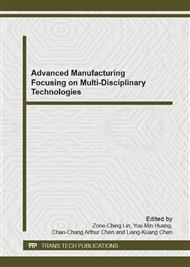[1]
L. Lin, C. Diver, J. Atkinson, R. Giedl-Wagner, H.J. Helml, Sequential laser and EDM micro-drilling for next generation fuel injection nozzle manufacture, Annals of the CIRP. 55 (2006) 179-182.
DOI: 10.1016/s0007-8506(07)60393-x
Google Scholar
[2]
Information on http: /www. bastech. com/3dprinting , 3D Bastech, Inc., last accessed on September 23, (2011).
Google Scholar
[3]
Information on http: /www. jemam. com/vertical. htm, JEM America Corp., last accessed on October 25, (2011).
Google Scholar
[4]
W.R. Chen, Parametric studies on buckling loads and critical speeds of microdrill bits, International Journal of Mechanical Sciences. 49 (2007) 935-349.
DOI: 10.1016/j.ijmecsci.2007.01.005
Google Scholar
[5]
B.W. Huang, The drilling vibration behavior of a twisted microdrill, Journal of Manufacturing Science and Engineering. 126 (2004) 719-726.
DOI: 10.1115/1.1813472
Google Scholar
[6]
L.A. Kudla, Deformations and strength of miniature drills, Proceeding of the Institution of Mechanical Engineers Part B: Journal of Engineering Manufacture. 220 (2006) 389-396.
DOI: 10.1243/095440505x69346
Google Scholar
[7]
L.A. Kudla, Fracture phenomena of microdrills in static and dynamic conditions, Engineering fracture mechanics. 78 (2011) 1-12.
DOI: 10.1016/j.engfracmech.2010.09.013
Google Scholar
[8]
D.G. Lee, H.G. Lee, P.J. Kim, K.G. Bang, Micro-drilling of alumina green bodies with diamond grit abrasive micro-drills, International Journal of Machine Tools & Manufacture. 43 (2003) 551-558.
DOI: 10.1016/s0890-6955(03)00021-x
Google Scholar
[9]
H.G. Lee, D.G. Lee, Tool life model for abrasive wet micro-drilling of ceramic green bodies, International Journal of Machine Tools & Manufacture. 44 (2004) 839-846.
DOI: 10.1016/j.ijmachtools.2004.01.003
Google Scholar
[10]
R.S. Jadoun, P. Kumar, B.K. Mishra, R.C.S. Mehta, Optimization of process parameters for ultrasonic drilling of advanced engineering ceramics using the Taguchi approach, Engineering Optimization. 38 (2006), 771-787.
DOI: 10.1080/03052150600733962
Google Scholar
[11]
D.Y. Chang, S.Y. Lin, Tool wear, hole characteristics and manufacturing tolerance in alumina ceramic microdrilling process, Materials and Manufacturing Processes. 27(2012), 306-313.
DOI: 10.1080/10426914.2011.577881
Google Scholar
[12]
F.C. Tien, C.H. Yeh, Using eigenvalues of covariance metrices for automated visual inspection of microdrills, International Journal of Advanced Manufacturing Technology. 26 (2005) 741-749.
DOI: 10.1007/s00170-003-1968-4
Google Scholar
[13]
C.K. Huang, Y.S. Tarng, C.Y. Chiu, A.P. Huang, Investigation of machine vision assisted automatic resharpening process of micro-drills, Journal of Materials Processing Technology. 209 (2009) 5944-5954.
DOI: 10.1016/j.jmatprotec.2009.07.013
Google Scholar
[14]
H. Watanabe, H. Tsuzaka, M. Masuda, Microdrilling for printed circuit boards (PCBs) – influence of radial run-out of microdrills on hole quality, Precision Engineering. 32 (2008) 329-335.
DOI: 10.1016/j.precisioneng.2008.02.004
Google Scholar
[15]
S.H. Yao, Y.L. Su, W.H. Kao, T.H. Liu, On the micro-drilling and turning performance of TiN/AlN nano-multilayer films, Materials Science and Engineering A. 392 (2005) 340-347.
DOI: 10.1016/j.msea.2004.09.050
Google Scholar
[16]
J.C. Su, C.K. Huang, Y.S. Tarng, An automated flank wear measurement of microdrills using machine vision, Journal of Materials Processing Technology. 180 (2006) 328-335.
DOI: 10.1016/j.jmatprotec.2006.07.001
Google Scholar
[17]
A.V. Atli, O. Urhan, S. Ertürk, M. Sönmez, A computer vision-based fast approach to drilling tool condition monitoring, Proceeding of the Institution of Mechanical Engineers Part B: Journal of Engineering Manufacture. 220 (2006) 1409-1415.
DOI: 10.1243/09544054jem412
Google Scholar


